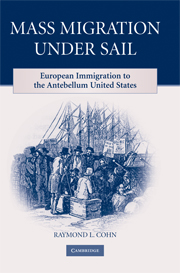Book contents
- Frontmatter
- Contents
- List of Tables and Figures
- Preface
- 1 A Unique Period for Immigration
- 2 The Onset and European Origins of Mass Immigration
- 3 The Jump in Immigrant Volume Around 1830
- 4 Push, Pull, and Other Factors in Antebellum Immigration
- 5 Who Were the Immigrants?
- 6 The Trip from Europe to the United States
- 7 The Immigrants in the United States
- 8 The Effects of Immigration on the United States
- 9 The End of Mass Migration Under Sail
- References
- Index
8 - The Effects of Immigration on the United States
Published online by Cambridge University Press: 30 June 2009
- Frontmatter
- Contents
- List of Tables and Figures
- Preface
- 1 A Unique Period for Immigration
- 2 The Onset and European Origins of Mass Immigration
- 3 The Jump in Immigrant Volume Around 1830
- 4 Push, Pull, and Other Factors in Antebellum Immigration
- 5 Who Were the Immigrants?
- 6 The Trip from Europe to the United States
- 7 The Immigrants in the United States
- 8 The Effects of Immigration on the United States
- 9 The End of Mass Migration Under Sail
- References
- Index
Summary
Among other events, the antebellum years in the United States saw the rapid development of manufacturing, a huge fall in internal transportation costs, changes in the distribution of income, and the largest outbreak of nativism in U.S. history. This chapter investigates the effects of immigration on the antebellum United States from both a theoretical and an historical perspective. These effects depend directly on the skill level and size of the immigrant stream, both relative to the native labor force. Numerical estimates of each factor are presented in the first section of this chapter, and they provide a basis for a discussion of the theoretical effects of immigration on the United States. Both overall and distributional effects occur, although the distributional effects of immigration are typically more important and discussions of these are the major focus of the historical events discussed in this chapter. Given the lack of government constraints on immigration, two features of the antebellum years discussed in previous chapters – the large increase in immigrant volume and the decline in the skill level of the immigrant stream – make the period of particular interest. Overall, immigration was no less controversial at this time than it is during the present day.
The Skill Level and Rate of Immigration
This section first determines the skill level of the arriving immigrant stream and then measures the rate of immigration, both relative to the native labor force.
- Type
- Chapter
- Information
- Mass Migration under SailEuropean Immigration to the Antebellum United States, pp. 190 - 222Publisher: Cambridge University PressPrint publication year: 2008

